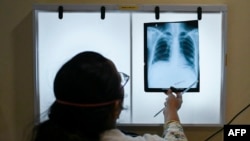In marking World TB Day, health officials warn the COVID-19 pandemic and multiple global crises are setting back years of progress in fighting tuberculosis and eventually ending the deadly disease.
Tuberculosis, an ancient disease that some say goes back to biblical times, kills more people than any other infectious disease. The World Health Organization says 1.6 million people globally died from TB in 2021 and an estimated 10.6 million people were newly infected.
Tuberculosis – a bacterial infection of the lungs – is a preventable, treatable and curable disease.
Significant inroads have been made in battling tuberculosis, with the WHO saying that TB deaths have dropped by nearly 40 percent globally since 2000. Additionally, the organization reports an estimated 74 million lives were saved through TB diagnosis and treatment.
While acknowledging the promising results, Tedros Adhanom Ghebreyesus, the WHO director-general, said progress in the fight against TB recently has stalled and even been reversed.
“The COVID-19 pandemic and conflicts in many countries have severely disrupted services to prevent, detect and treat TB.”
As a result, he said the “WHO last year reported an increase in TB deaths for the first time in more than a decade” as well as an increase in the number of people falling ill with TB and drug-resistant TB.
He deplored the enormous impact of the ongoing epidemic on families and communities.
“We cannot truly end TB unless we address its drivers.”
Those, he said, included conditions of “poverty, malnutrition, diabetes, HIV, tobacco and alcohol use, poor living and working conditions, stigma and discrimination.”
The WHO says the largest number of new TB cases – 46% – occurred in the Southeast Asian region (or Southeast Asia), followed by the African region with 23% and the Western Pacific with 18%.
While the numbers remain high, WHO Regional Director for Africa Matshidiso Moeti observed that the continent has made progress in recent years in combating TB. For example, she noted that deaths in the region have fallen by 26% between 2015 and 2021.
“We do still face some challenges, notably delayed diagnosis and testing, since 40 percent of people living with TB did not know their diagnosis or the disease was not reported in 2021.
“Moreover, an estimated 1 million people are living with TB in the region, yet to be detected,” she said.
WHO chief Tedros’ five-year flagship initiative on TB, which he launched in 2018, seeks to build on the progress achieved by improving delivery of quality care to people living with TB.
Under the program, the WHO has provided two new TB drugs and 12 new TB diagnostic tests to more than 100 countries.
Tereza Kasaeva, director of the WHO’s global tuberculosis program, said the WHO, for the first time, has recommended “a fully oral, two to three times shorter and more effective treatment, including for the most severe forms of multi-resistant TB.”
Jeff Acebo, a TB and HIV survivor from the Philippines and a member of the WHO’s civil society task force, welcomed the development.
He said for too long, people with multidrug resistant TB “have struggled with painful injections, longer regimens, side effects and catastrophic out-of-pocket costs.
“We strongly urge governments, especially one with [a] high burden of TB, to roll out and accelerate the implementation of the novel six-month all-oral regimen treatment,” which he said “would improve the quality of life” for those suffering from the disease.
Given its success, Tedros said, “we have decided to extend the initiative for a further five years, until 2027 and broaden its scope.”
In 2015, the United Nations set a target date of 2030 to end the global TB epidemic as part of its sustainable development goals. In September, world leaders will meet in New York for the second high-level meeting on TB to invigorate the flagging process.
Tedros said he believes the meeting should be a turning point in the fight against TB – if leaders make real and lasting commitments to invest the financial resources needed to end it.
Lucica Ditiu, executive director of the Stop TB Partnership, echoed those sentiments.
“We have new innovations now to help us save lives—new diagnostic tools, shorter, less toxic treatment regimens and new digital tools,” she said.
“When we add the political muscle that the UNHLM [U.N. high level meeting] will gather to the many dedicated health care professionals already in the front lines,” she said, “ending TB looks increasingly possible.”
